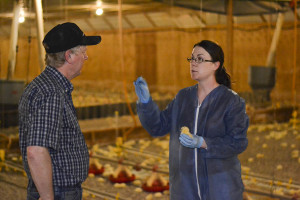Making Sense of the New Federal Rules on Antibiotics in Chicken Production
With 2017 in full gear, there are new rules already taking effect. One of those new rules specifically affects U.S. livestock and poultry producers and the antibiotics they can administer.
Since federal rules can be confusing – and so can the topic of antibiotics – we wanted to help make sense of the new federal antibiotics rules, and dig a little deeper into how they affect chicken producers.
What exactly are the new federal antibiotics rules?
Known technically as Guidance for Industry #213, effective January 1, 2017, this FDA rule no longer permits livestock and poultry producers to give antibiotics to animals to make them gain weight, and antibiotics that are also used in human medicine must be prescribed by a veterinarian, for the sole purposes of addressing disease.

A veterinarian consults with a chicken farmer.
Now, let’s break down what that all that actually means.
There are a lot of different types of antibiotics. Both the FDA and World Health Organization (WHO) rank antibiotics relative to their importance in human medicine. The highest ranking is “critically important.” Antibiotics in this category are used sparingly to treat sick birds. Antibiotics in other less-important classes may be used in chicken production to maintain poultry health and welfare, including for disease prevention, control and treatment purposes.
So while the majority of antibiotics used in raising chickens are not used in human medicine, now antibiotics that are important to human medicine will be labeled for use in food animals only to address disease, and not to promote growth, and will be used exclusively under the supervision and prescription of a veterinarian.
What’s the purpose of the new antibiotics rules?
According to FDA, the purpose of the new rules is to preserve the effectiveness of antibiotics used to treat human illness and decrease the resistance of foodborne pathogens.
Although there is scientific acknowledgement that the use of antibiotics in people is the primary source of antibiotic resistance, the animal health community recognizes that antibiotics must be used responsibly in food animals to minimize agriculture’s contribution to antibiotic resistance. That’s why the agriculture community and FDA are working together to implement the new rules, in order to ensure the responsible use of antibiotics in livestock and poultry.
Is this going to be difficult for chicken producers to implement?
Not at all. Chicken producers have been leaders in reducing antibiotic use and many producers eliminated the use of medically important antibiotics for growth promotion far ahead of this deadline.
So chicken producers can still use antibiotics if their birds are sick, right?
Absolutely. Treating illness is a responsible part of animal care. If chickens are sick, farmers work with animal health experts and veterinarians to determine if an antibiotic is needed.
Of the antibiotics that are used to treat and prevent disease, a class of antibiotics called ionophores (and another group of medicines called non-antibiotic coccidiostats) is commonly used to treat the most important and potentially devastating parasitic diseases we have in poultry – coccidiosis. Not only are both of these medicines not growth promoters and have no FDA-approved use for growth promotion, they are not used in human medicine – ever.
Although antibiotics are very effective at treating disease, antibiotics aren’t the only tool to keep chickens healthy – chicken producers use a variety of tools including: individualized nutrition plans; the use of probiotics and vaccines; adjusted air circulation and temperature controls; and training programs and education efforts for farmers and service technicians.
Whether or not antibiotics are used – what’s the bottom line?
The bottom line for farmers, veterinarians and chicken companies is that we’re raising healthy chickens, because healthy chickens are directly related to a safe food supply. Not only are we all consumers, but we all have a vested interest in protecting the effectiveness of antibiotics, for the welfare of the birds. To do any differently would not make sense from a moral or business standpoint.
The bottom line for consumers is that there are many choices and products that they can spend their food dollars – whether it’s traditional chicken, raised without antibiotics, organic, etc.
Importantly, even if a chicken is given antibiotics in the course of its life to treat or prevent disease, the bird must go through a withdrawal time before leaving the farm. In addition, FDA and USDA have extensive monitoring and testing programs to make sure that food at the grocery store does not contain harmful antibiotic residues.
If you’re interested to learn more about antibiotic use on chicken farms, this FAQ provides a detailed overview.
Post written by Kourtney Determan, Manager of Strategic and Digital Communications at National Chicken Council